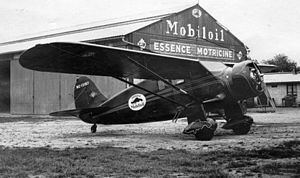 | ||
The Stinson Model R was an American light aircraft built by the Stinson Aircraft Company in the early 1930s. It was a single-engine high-winged monoplane, developed from the Stinson Junior. 39 examples were built.
Contents
Design and development
In 1931, work began on a replacement for Stinson's SM-8 Junior four-seat light aircraft. The new design, the Model R, while based on the SM-8, had a shorter fuselage and a revised cabin. While the aircraft's undercarriage retained the basic tailwheel undercarriage layout of the SM-8, the split-axle mainwheels of the earlier aircraft were replaced by a semi-cantilever design, in which the mainwheels and shock-absorber units were enclosed in streamlined fairings attached to a short stub wing, which was also used to carry wing bracing struts. The aircraft had a fabric covered, welded steel-tube fuselage, while the wings were of mixed construction, with spruce spars and steel ribs, covered by fabric.
A retractable undercarriage was also designed for the Model R, with the mainwheels retracting upwards and inwards into the lower fuselage. This had less benefit to the aircraft's performance than was expected, however, and only a few aircraft were built with the retractable undercarriage. The aircraft was powered by a single Lycoming R-680 radial engine (Lycoming was controlled by the Cord Corporation, which also owned a controlling stake in Stinson, and so were the preferred powerplants for Stinson aircraft).
Operational history
The prototype made its maiden flight, piloted by Edward Stinson, in autumn 1931 and was certified as airworthy on 25 January 1932. Edward Stinson then set off on a sales tour with the prototype, and on the evening of that day, was carrying out a demonstration flight from Chicago when fuel shortage forced him to attempt a forced landing. Stinson received fatal injuries in the resultant crash.
Production continued, but the Great Depression caused sales to be slow, and only a total of 39 aircraft were built, including 5 Model R-3s fitted with retractable undercarriage. It was succeeded in production by the Stinson Reliant, which managed similar performance but was significantly cheaper ($3995 compared with $5595 for the Model R and $6495 for the R-3).
Variants
Specifications (Model R)
Data from General Dynamics Aircraft and their Predecessors
General characteristics
Performance
